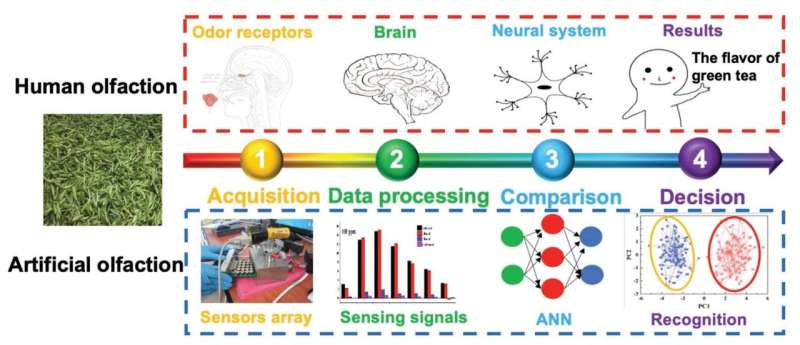This article has been reviewed according to Science X's editorial process and policies. Editors have highlighted the following attributes while ensuring the content's credibility:
fact-checked
peer-reviewed publication
trusted source
proofread
Electronic noses sniff out volatile organic compounds

Volatile organic compounds (VOCs) are chemicals emitted as gases that can have adverse health effects. They are often found in paints, pharmaceuticals, and refrigerants, among other common products, but they can also act as markers of explosives, insect infestation, food spoilage, and disease.
Tracing VOCs is important for public safety and all "smell" related issues. To this end, Liu and colleagues introduced a fluid mechanics-based chamber design for an electronic nose (e-nose) that consistently detects VOCs at low concentrations. The strategy, which includes using a shunt-like device to control the behavior of fluid flow, is a step forward in e-nose technology development. Their article "Controlling fluidic behavior for ultrasensitive volatile sensing" was published in Applied Physics Reviews on May 23, 2023.
Methods for detecting VOCs face many challenges in terms of selectivity, sensitivity, reproducibility, and stability. E-noses, inspired by the olfactory system, can overcome some of these barriers by combining arrays of chemical sensors with pattern recognition techniques to recognize odors.
However, many e-noses generate different signals toward VOCs of the same concentration when the sensor is located in different parts of the "nose" chamber.
"To counteract this problem, the fluidic behavior of the gas flow needs to be well controlled," said author Weiwei Wu. "This ensures a uniform fluidic field and concentration of VOCs in the chamber and avoids generating any fake sensing characteristics."
The starting e-nose design featured a vertical chamber that looks much like a showerhead. This promotes vertical flow as gas spreads through holes at the bottom of the device and around to evenly distributed sensors.
Using fluid mechanics simulations, the team optimized the volume, symmetry, hole location, and sensor location of their e-nose chamber. They added a shunt-like device to promote fluid flow and shorten response time.
Based on their simulation results, the researchers fabricated a Teflon chamber and measured the sensing performance of their e-nose. They compared two chambers, one with the shunt and one without. The chamber with the shunt device consistently performed around 1.3 times better at sensing an example VOC.
In the future, the authors plan to focus on minimizing the chamber and improving the structure further to decrease response and recovery time.
"E-nose research is a highly interdisciplinary field," said Wu. "Chemists, physicists, biologists, electronics engineers, and data scientists need to work together to solve issues including effective sensing that considers the fundamental mechanisms of absorption/desorption, algorithms that achieve precise recognition of VOCs more quickly and with lower energy consumption, and how new technologies, such as memristors, should be involved."
More information: Controlling fluidic behavior for ultrasensitive volatile sensing, Applied Physics Reviews (2023). DOI: 10.1063/5.0141840
Journal information: Advanced Materials Technologies , Applied Physics Reviews
Provided by American Institute of Physics





















